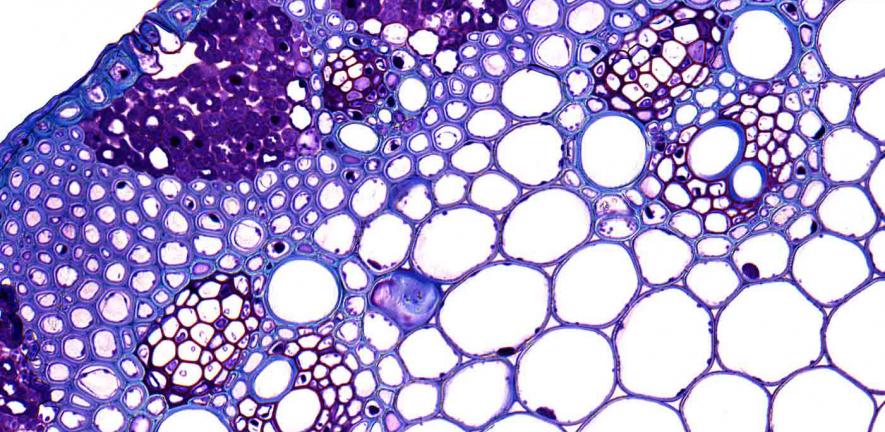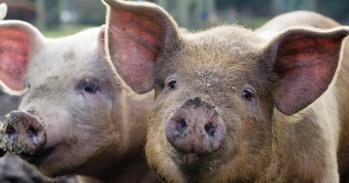
Newly discovered family of genes could help us breed grasses with improved properties for food and fuel.
Newly discovered family of genes could help us breed grasses with improved properties for food and fuel.
Unlike starchy grains, the energy stored in the woody parts of plants is locked away and difficult to get at. Just as cows have to chew the cud and need a stomach with four compartments to extract enough energy from grass, we need to use energy-intensive mechanical and chemical processing to produce biofuels from straw.
Professor Paul Dupree, of the University of Cambridge's Department of Biochemistry
Researchers from the Biotechnology and Biological Sciences Research Council (BBSRC) Sustainable Bioenergy Centre (BSBEC) have discovered a family of genes that could help us breed grasses with improved properties for diet and bioenergy.
The research was carried out by a team from the University of Cambridge and Rothamsted Research, which receives strategic funding from BBSRC. Their findings are published today (Tuesday 17 Jan) in the journal Proceedings of the National Academy of Sciences (PNAS).
The genes are important in the development of the fibrous, woody parts of grasses, like rice and wheat. The team hopes that by understanding how these genes work, they might for example be able to breed varieties of cereals where the fibrous parts of the plants confer dietary benefits or crops whose straw requires less energy-intensive processing in order to produce biofuels.
The majority of the energy stored in plants is contained within the woody parts, and billions of tons of this material are produced by global agriculture each year in growing cereals and other grass crops, but this energy is tightly locked away and hard to get at. This research could offer the possibility of multi-use crops where the grain could be used for food and feed and the straw used to produce energy efficiently. This is crucial if we are to ensure that energy can be generated sustainably from plants, without competing with food production.
Professor Paul Dupree, of the University of Cambridge's Department of Biochemistry, explains, “Unlike starchy grains, the energy stored in the woody parts of plants is locked away and difficult to get at. Just as cows have to chew the cud and need a stomach with four compartments to extract enough energy from grass, we need to use energy-intensive mechanical and chemical processing to produce biofuels from straw.
“What we hope to do with this research is to produce varieties of plants where the woody parts yield their energy much more readily – but without compromising the structure of the plant. We think that one way to do this might be to modify the genes that are involved in the formation of a molecule called xylan – a crucial structural component of plants.”
Xylan is an important, highly-abundant component of the tough walls that surround plant cells. It holds the other molecules in place and so helps to make a plant robust and rigid. This rigidity is important for the plant, but locks in the energy that we need to get at in order to produce bioenergy efficiently.
Grasses contain a substantially different form of xylan to other plants. The team wanted to find out what was responsible for this difference and so looked for genes that were turned on much more regularly in grasses than in the model plant Arabidopsis. Once they had identified the gene family in wheat and rice, called GT61, they were able transfer it into Arabidopsis, which in turn developed the grass form of xylan.
Dr Rowan Mitchell of Rothamsted Research continues, "As well as adding the GT61 genes to Arabidopsis, we also turned off the genes in wheat grain. Both the Arabidopsis plants and the wheat grain appeared normal, despite the changes to xylan. This suggests that we can make modifications to xylan without compromising its ability to hold cell walls together. This is important as it would mean that there is scope to produce plant varieties that strike the right balance of being sturdy enough to grow and thrive, whilst also having other useful properties such as for biofuel production."
The tough, fibrous parts of plants are also an important component of our diet as fibre. Fibre has a well established role in a healthy diet, for example, by lowering blood cholesterol. The team have already demonstrated that changing GT61 genes in wheat grain affects the dietary fibre properties so this research also offers the possibility of breeding varieties of cereals for producing foods with enhanced health benefits.
Duncan Eggar, BBSRC Bioenergy Champion said: “Recent reports have underlined the important role that bioenergy can play in meeting our future energy needs – but they all emphasise that sustainability must be paramount.
“Central to this will be ensuring that we can get energy efficiently from woody sources that need not compete with food supply. This research demonstrates how, by understanding the fundamental biology of plants, we can think about how to produce varieties of crops with useful traits, specifically for use as a source of energy.”
This work is licensed under a Creative Commons Licence. If you use this content on your site please link back to this page.





